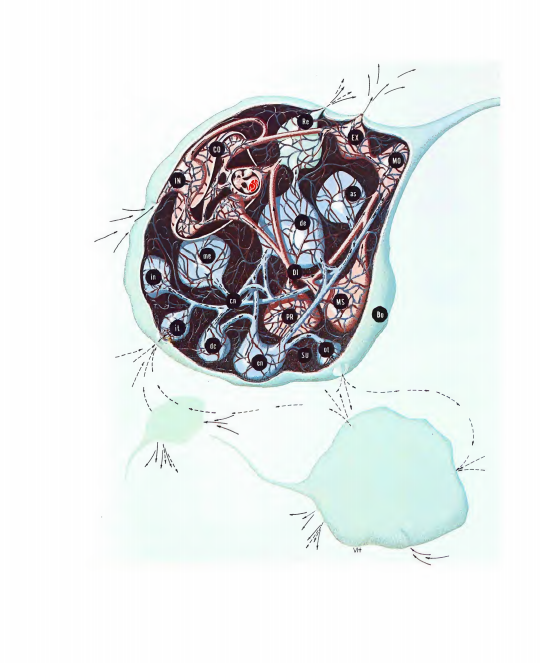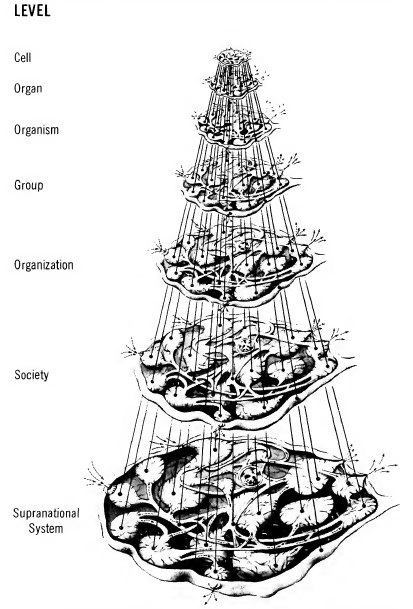The 1100+ page Living Systems book published in 1978 by the founder of Behavioral Science in 1956, James Grier Miller, became available as a softcopy on the Internet Archive in May 2017.
What is a living system and what does it do? Many scientists coming from diverse scientific backgrounds, when engaged in the search for general principles to integrate our understanding of the phenomena of life, have placed major emphasis on the notion of living systems composed of interrelated units. The various “systems theories” differ greatly in their concepts and definitions of basic terms. Their common goal is to organize the findings in some or all of the sciences of life and behavior into a single conceptual structure.
1. One general theory of living systems
The general living systems theory which this book presents is a conceptual system concerned primarily with concrete systems (see page 17) which exist in space-time. Complex structures which carry out living processes I believe can be identified at seven hierarchical levels (see page 25) — cell, organ, organism, group, organization, society, and supranational system. My central thesis is that systems at all these levels are open systems composed of subsystems which process inputs, throughputs, and outputs of various forms of matter, energy, and information. I identify 19 critical subsystems (see page 32 and Table 1-1) whose processes are essential for life, some of which process matter or energy, some of which process information, and some of which process all three. Together they make up a living system, as shown in Fig. 1-1. In this table the line under the word “Reproducer” separates this subsystem from the others because that subsys- tem differs from all the others by being critical to the species or type of system even though it is not essen- tial to the individual. Living systems often continue to exist even though they are not able to reproduce. Subsystems in different columns which appear oppo- site each other have processes with important similar- ities — for instance, the processes carried out by the ingestor for matter and energy are comparable to those carried out by the input transducer for information. In general the sequence of transmissions in living systems is from inputs at the top of Table 1-1 to outputs at the bottom, but there are exceptions. [p. 1]
Fig. 1-1 A generalized living system interacting and intercommunicating with two others in its environment.
Subsystems which process both matter-energy and information: Reproducer (Re); Boundary (Bo).
Subsystems which process matter-energy: Ingestor (IN); Distributor (DI); Converter (CO); Producer (PR); Matter-energy storage (MS); Extruder (EX); Motor (MO); Supporter (SU).
Subsystems which process information: Input transducer (IT); Internal transducer (IN); Channel and net (CN); Decoder (DC); Associator (AS); Memory (ME); Decider (DE); Encoder (EN); Output transducer (OT). [p. 2]
Systems at each of the seven levels, I maintain, have the same 19 critical subsystems. The structure and processes of a given subsystem are more complex at a more advanced level than at the less advanced ones. This is explained by what I call the evolutionary principle of “shred-out,” a sort of division of labor (see Fig. 1-2). Cells have the 19 critical subsystems. When mutations occurred in the original cells, the mutant could continue to exist only if it could carry out all the essential processes of life of the 19 subsystems; otherwise it would be eliminated by natural selection. The general direction of evolution is toward greater complexity. As more complex cells evolved, they had more complex subsystems, but still the same 19 basic pro- cesses. Similarly as cells evolved into more complex systems at advanced levels — organs, organisms, and so on — their subsystems shredded out into increasingly complicated units carrying out more complicated and often more effective processes. If at any single point in the entire evolutionary sequence any one of the 19 subsystem processes had ceased, the system would not have endured. That explains why the same 19 subsystems are found at each level from cell to supra- system. And it explains why it is possible to discover, observe, and measure cross-level formal identities (see page 17). [pp. 1,4]
Fig. 1-2 Shred-out. The generalized living system (see Fig. 1-1) is here shown at each level. The diagram indicates that the 19 subsystems at the level of the cell shred out to form the next more advanced level of system, the organ. This still has the same 19 subsystems, each being more complex. A similar shredding-out occurs to form each of the five more advanced levels — organism, group, organization, society, and supranational system. [p. 4]For each subsystem I identify about a dozen variables representing different aspects of its processes. It would be easy to identify more if one wanted an exhaustive list. Each of these variables can be measured at each of the levels, and the sorts of variation discovered can be compared across the levels. The interactions between two or more variables in a single subsystem or in multiple ones can also be observed, measured, and compared across the levels. This is how cross-level formal identities, basic to a general theory of living systems, can be examined (see page 27).
This book is an effort to integrate all the social, biological, and physical sciences that apply to structure or process at any of the seven levels. Physiology, biochemistry, genetics, pharmacology, medicine, economics, political science, anthropology, sociology, and psychology are all almost entirely relevant. Physical science and engineering also contribute. Logic, mathematics, and statistics yield methods, models, and simulations, including some involving the relatively new approaches of cybernetics and information theory. [p. 4]
References
Miller, James Grier. 1978. Living Systems. McGraw-Hill. https://archive.org/details/LivingSystems.


You must be logged in to post a comment.